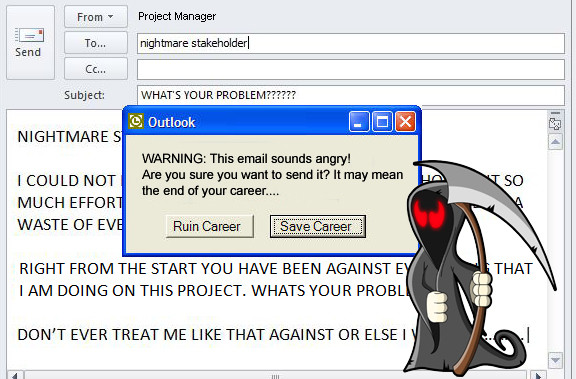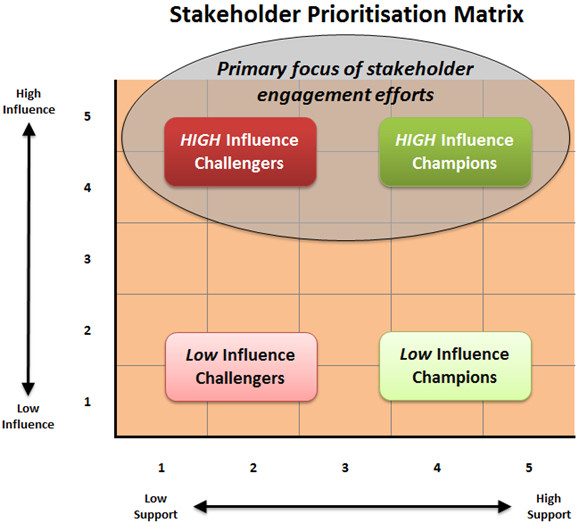It’s inevitable like death and taxes – every project manager in their career will eventually run into a stakeholder on a project that proves to be a nightmare in some form or another.
Failing to correctly deal with problem stakeholders could easily be the undoing of both the project and its project manager.
Firstly, let’s look at how a stakeholder is defined:
PRINCE2: “Any individual, group or organization that can affect, be affected by, or perceive itself to be affected by, an initiative (programme, project, activity, risk).
PMI: “Persons and organizations such as customers, sponsors, performing organization and the public, that are actively involved in the project, or whose interests may be positively or negatively affected by execution or completion of the project. They may also exert influence over the project and its deliverables.”
MSP: “Any individual, group or organisation that can affect, be affected by, or perceive itself to be affected by, a programme. Any person or entity who can affect an endeavour / project, or be affected by it, or be perceived itself to be affected is a stakeholder.
Here are my 8 tips for dealing with stakeholders that prove to be difficult, problematic, irrational, and in general – a nightmare to work with!
Ok – let’s get into them:
Tip 1: Believe in yourself – you can work through it
It may sound like an old cliché and be the briefest tip on here, but it will get you 50% of the way there.
You must believe that you have it within yourself and that you are committed to working through the problems and issues you have with your nightmare stakeholder.
If you don’t really believe you can work through the issues for any reason, you will indeed most likely fail. Your negative actions and reactions will get you there – think self-fulfilling prophecy.
It starts with YOU!
Tip 2: Change how you perceive them
It’s very easy to have the negative perception that your nightmare stakeholder is out to cause disruption to your project with no regard but to themselves or, even worse that they are out to get you personally.
This may be especially true if they have been attacking your project with borderline insinuations that you may be incompetent.
With this negative perception, you are more likely to formulate a defensive resolution strategy that may resemble the following:
- I need to be more defensive about the project and my work
- > > > so they know I can’t be messed with
- I should avoid them whenever it’s possible
- > > > to avoid confrontation
- I should provide as little information as possible
- > > > so they have less to attack
- I need to convince others that the stakeholder is of bad character
- > > > to try and isolate them
- With all this…
- > > > they will come to their senses and quietly align to the project!
Instead, change your negativity and emotional bias towards the stakeholder to a more positive perception.
View the stakeholder as a GOOD INTENTIONED CHALLENGER who believes that they are doing the right thing and are making a case for it the best way they know how.
This is a much better basis for you to start planning how to resolve issues and to move forward with your stakeholder. I know this will be extremely difficult in some circumstances however you will be much better for it.
This attitude will also be seen as a lot more professional, pragmatic and constructive by all the other stakeholders.
Tip 3: Never take it personally – EVER
The moment you start taking whatever problems your stakeholders are throwing at you personally – it’s time to stop and ask yourself if you are really fit to continue running the project.
You will be constantly put off your ‘A’ Game and it’s a downward spiral that can be very difficult to recover from once you get sucked in.
Some early signs that you may be heading down in this direction include urges to reflex respond in kind to emails from the problem stakeholder.
Another is feeling the need to argue with the problem stakeholder in meetings or workshops to prove yourself.
In both cases, all you would be doing is increasing the tension and making the price of resolution more costly, difficult and elusive by adding more emotion into the mix.
Instead, create a space between yourself and your reactions – wait a day or so and when you are ready, respond in order to gain clarification.
Try to master the art of rising above it all and gain the distinct advantage of remaining calm, collected and in full emotionally control in confrontational, irrational or chaotic situations.
The psychology and reasoning behind why you should not take things personally is very well articulated in the The Four Agreements by Don Miguel Ruiz.
Here are some excerpts from the book:
“Whatever happens around you, don’t take it personally… Nothing other people do is because of you. It is because of themselves. All people live in their own dream, in their own mind; they are in a completely different world from the one we live in. When we take something personally, we make the assumption that they know what is in our world, and we try to impose our world on their world.
Even when a situation seems so personal, even if others insult you directly, it has nothing to do with you. What they say, what they do, and the opinions they give are according to the agreements they have in their own minds…”
Tip 4: Don’t ignore them
One of the worst things that you can do is to ignore the stakeholders that are challenging you and your project – especially when they have high influence.
It’s tempting to believe that if you retreat and ignore them that somehow, they will just soften their stance or simply forget it over time. In reality, this very rarely ever happens, if ever.
The matrix below shows you where you should be focusing most of your stakeholder engagement efforts:
Ignoring your High Influence Challengers can put you at a disadvantage in the following ways:
- They will be left feeling greatly disrespected that you are not doing anything to address their issues – You will also appear to be coming from a position of weakness.
- They will source information from elsewhere to use and justify their concerns – some of which may not be accurate.
- Genuine underlying issues that you are not aware of will snowball.
- They will have cause and opportunity to influence others to their way of thinking and using information they collected – They will do the teaching.
- You will end up having to justify you and your project’s position on their terms and on a stage that they have prepared and set – rather than on your terms and to your strategy.
Instead make it a primary focus to maximise your stakeholder engagement with both High Influence Champions and especially High Influence Challengers.
Here are the advantages you will have:
- They will respect that you are taking steps to address and resolve their issues even if they disagree – You will also appear to be coming from a position of strength.
- They will source information directly from you – and share any information they have with you – you will have great awareness of their information and what they are looking at.
- You will learn of any new issues you may not have known about first hand rather from others.
- You will be in a much better position to influence others knowing all the information and the issues – You can do the teaching
- They will more than likely participate in your resolution strategy which will be on your terms and on the stage that you prepare and set.
Tip 5: Know your position and support
When you are managing political projects with demanding stakeholders, make sure you have the full support of your home team for the direction your project is taking – otherwise you could be setting yourself up for a major fall.
Think: Getting attacked by your own pieces in a game of chess!
So, if you’re a Project Manager working within the IT Department on a difficult project, do you have the full support for your project all the way up to the CIO who will firmly stand behind you?
Or are there several influential skeptics along the way and your CIO seems to waver in their support?
If this is the case, your first priority should be to gain a single agreed and accepted position that your home team can all get behind – before you start dealing with outward stakeholders external to the business unit.
Tip 6: Separate the PERSON from the problem
Your goal here is to reach the point where you and your stakeholder feel as part of the same team – both working together towards solving a common problem without trying to dig each other out of entrenched positions.
You eliminate the counter-productive “Them” vs. “Us” mentality and defensive posturing where issues are entangled with both emotion and ego.
Here are some ways to help you get there:
Engage:
- Continually engage and communicate with them.
- Meet face to face whenever possible.
Listen:
- Listen to what they say rather than how they say it.
- Don’t discredit or play down their emotions or opinions.
- Always be respectful, even when they try to aggravate or anger you.
- Confirm your understanding of the issues by repeating back your understanding – this enables you to pull the facts from what is being expressed.
Discover:
- Establish what you are both in agreement of, as well as what the sticking points are.
- The first thing that can be agreed is that the problem or issue your stakeholder has needs to be resolved.
- Bring it down to basic elements and specifics where possible.
- Keep the business objectives in focus.
Establish Trust:
- Establish trust by being truthful, admitting instances you have been wrong and following up on things you agreed to do on time.
- Seek to maintain and continue a good working relationship regardless of any unresolved differences that may remain.
Action:
- Involve them in the resolution process appropriately and clearly define their role and responsibility.
- Document and share your meeting minutes with particular focus on what was agreed, the required action items and their time-frames.
Post- Resolution:
- Maintain frequent communication with your stakeholder regarding the status of the project – this will make them feel as part of the team.
- Recognise their efforts in the success of your project – this will make it much easier to work together in the future.
By separating the person from the problem, you will also be able to better determine and fix the root cause of the problem.
Root causes you come across may include some of the following:
- Belief the project has ulterior motives.
- There is technical reason why it won’t work.
- Extreme fear of change with an underlying sense of insecurity.
- Previous bad experience when working on a similar project.
- Belief that there is a better way to do it.
- Not being involved early on in the project and feel completely left out.
- Miscommunication about the project by someone or others / not aware of all the facts.
- Not being able to understand something and getting lost in the jargon.
- Don’t want you to scratch the surface to find out something.
- Strong unresolved personal issues between them and someone on your team.
- They don’t want to deal with someone new or unproven to them.
- They don’t believe you can grasp their requirements and issues.
- It interferes or hinders with their professional ambitions.
Tip 7: Adjust your style and apply some emotional intelligence
In some cases, you may perceive a stakeholder as being difficult and having a major issue – whereas the reality is that it’s a personality clash and difference in communication styles and you’ve built it up to something it’s not.
This is where applying some emotional intelligence and adjusting your communication style can be a major help.
For example, if you’re sending them an email:
- If your stakeholder is brief, to the point and never seems to have much time to spare, make their life a little easier by also being brief and to the point in your communication. Put what you wish to convey within your first sentence. Don’t add it at the end after an essay of detail and justification you expect them to read.
- If your stakeholder likes detail and analysis to formulate their own position, then make sure you provide reference to this in your communication – rather than a lack of it.
- If your stakeholder is not good dealing with emails, then pick up the phone and convey your message verbally or better still, go and see them face to face.
Tip 8: Ask for help
One of the best ways to solve any particular challenging problem is to ask for help from others who have the capability and are in the position to provide it.
Don’t equate asking for help as a failure on your part – instead think of it as an effective strategy in your arsenal to getting problems solved!
As a Project Manager, you should be continually communicating to your Project Board, Programme Manager, Project Director or any other direct reporting authority, the status of your project including any problems that may start arising from stakeholders.
Don’t leave it until the eleventh hour, or after the situation has got out-of-control before communicating up any stakeholder issues to those you need to.
They won’t appreciate being the last to know and in addition having to deal with an inflamed situation they could have easily helped you resolve much earlier on in the process.
Also, choose your battles wisely – don’t try to be a hero and deal with stakeholder holder issues on your own where it may not be appropriate for you to do so, or where it’s beyond your responsibility.
For instance, if you’re an IT Project Manager and you are starting to have problems with the CFO, it would be more appropriate for the CIO to help you resolve the issue at their level – rather than you trying to do so at your level.
Conclusion:
Dealing with difficult stakeholders is as much about YOU as it is about THEM.
The first part is about changing your own thinking and perceptions so that you will have the right attributes to execute the second part which entails the actual strategy and processes needed to resolve your difficult stakeholder issues.
What experiences have you had dealing with tough stakeholders – and how did you overcome them?
RELATED READING:
You may also like:
- 9 costly mistakes – Project Portfolio Management Implementations
- Is Your Company Rubbish at Projects? – (problem may not be where you think)
About Rick Ktorides, Senior Project Manager

Rick Ktorides is a Senior Project Manager/Consultant who has successfully delivered a wide variety of complex projects across Australia, Asia, Europe and North America to business end-users across various levels and industry verticals.
As Frontline’s Senior Project Manager, Rick offers project management services to our customers across Application, Development and Infrastructure Projects.





